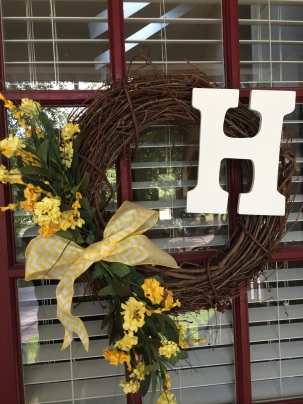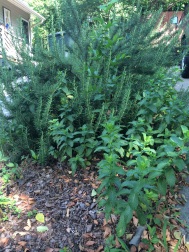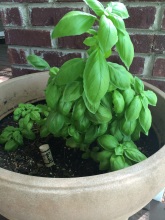Tags
basil, cilantro, foodie, gardening, green thumb, herbs, home, mint, parsley, plants, rosemary, thyme
I say “once again,” because I’ve tried to grow an herb garden something like 5 times, never really having success. The first time, I decided I was going to be really delusional ambitious and start out with seeds. Three guesses as to how many of those actually even sprouted… (I’ll give you a hint: it was zero).
So this year I decided to do a little research first (did I hear somebody say “duh?”). I looked up some plants that could survive my brown thumb in the shade (since they’d be on my porch), and were supposedly “easy to grow,” hopefully meaning that even I can’t kill them.
From my research, I gathered that basil, thyme, oregano, parsley, and chives don’t mind the shade, and are good little “beginner” herbs. I grew oregano last year, though, and rarely used it, so I chose the others instead (plus, I only have so many pots to fill…). I’ve yet to find the chives, but so far I’ve planted basil, parsley, cilantro and thyme.
I also learned that basil should be watered regularly (but not too much), and that cilantro really doesn’t need a ton of water (no wonder it was always the first to go!). Also, herbs need to be used in order for them to keep growing. I noticed that my cilantro was looking a little droopy the other day, but after pulling off the sad-looking leaves to throw into my pico de gallo, it perked right up. (See below for more ideas on using herbs.)Most people already know this, but if you see flowers growing on your herbs, you need to trim those off. Otherwise, the plant focuses on pollination rather than growing. Once it flowers, you’ll notice that the herb begins to get tall and skinny, rather than full and lush. So just take your shears (or, in my case, scissors, or sometimes just my fingernails…) and get rid of the bud, and then watch your plant go back to normal.
South Carolina is a great place to grow herbs, because we have a fairly mild climate, meaning that while it is H.O.T. in the summer, we have very few freezes in the winter months, and plenty of rain year-round. So as long as you water your plants fairly regularly, you should be pretty successful (unless, of course, your name is Lindsay…)
Ways to use herbs*:
Cilantro:
Rosemary:
- Rosemary Shrimp Skewers
- Chicken Marinade
- Rosemary Citrus Water
- Garlic Rosemary Roasted Sweet Potatoes
Basil:
Thyme:
Parsley:
Mint:
*Side note: I’ve not tested all of these exact recipes, but they were the closest I could find to ones I’ve made at home before.




